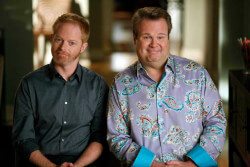An LGBT history of television
When television was young, it represented a world where families must be one way, and nothing else. The majority of characters portrayed were straight, cis, and happily-married.
However, as television’s popularity increased, producers and writers began to realise how important it was to include a variety of different storylines and influences.
The first same-sex couple in LGBT TV history was in the 1972 TV-Movie That Certain Summer. In it, a gay male couple live in secret until one of the man’s sons discovers his father’s relationship.
That Certain Summer has since been praised for portraying gay characters in a sympathetic manner, and was very well received
From this point, introducing LGBT characters in television has been increasingly more accepted.
Well-loved shows, which have been going on for years, are beginning to bring in LGBT characters. For example, there are plans for The Simpsons to have an episode where Smithers comes out to Mr Burns.
Children’s television shows are also introducing more LGBT characters, such as The Legend of Korra and Steven Universe.
Over the years, many shows have been pioneers for LGBT representation.

Arizona (left) and Callie (right). Image: Richard Cartwright, American Broadcasting Companies Inc., and Sky
One such show is Grey’s Anatomy, which features Callie Torres (Sara Ramirez). Callie was married for a short period of time to George O’Malley (T.R. Knight) during the show’s second season and, when they later get divorced, Callie then ends up marrying Arizona Robbins (Jessica Capshaw).
Callie Torres identifies as bisexual, and we are given the chance to witness and her journey as she discovers her sexual orientation. We also get to see her friends and co-workers support her, as well as the difficulties she faces, such as family members not fully accepting who she is.
Another ground-breaking show is Netflix’s Orange is the New Black. One of its key characters is Sophia (Laverne Cox), a black trans woman who also has a wife and son. The show deals with Sophia’s experience of coming out as a woman: we get to see the strong love she still shares with her wife; other people’s reactions, both supportive and discriminatory; and Sophia’s family learning to love and accept her for who she is.
One of the biggest changes we have seen in LGBT TV representation is a greater acceptance. During the hit television show Friends, Ross Geller’s (David Schwimmer) ex-wife re-married a woman – the reaction at the time was much bigger than what we might expect today, as LGBT characters are now being seen more often on TV. LGBT characters’ LGBT identities are no longer the only important things about them.
The type of representation has also changed since LGBT characters were first introduced to TV.
In the early stages, LGBT characters were presented as less than their straight, cis counterparts, and not capable of having the same rights, jobs, and lives. Today, we are more able to see LGBT characters as capable of having the same standard of living

Mitchell (left) and Cameron (right). Image: Fox and Sky
In Modern Family, Cameron Tucker (Eric Stonestreet) and Mitchell Pritchett (Jesse Ferguson) are a gay couple who have made a family with their daughter. Mitchell works as a lawyer, and Cameron stays at home to be with their daughter.
In the near future, it would be great to see more acceptance of LGBT characters within the shows, as well as their struggles and journeys.
These stories allow us as viewers to appreciate what the character has gone through, and to feel a part of that journey. It also helps LGBT viewers to come to terms with themselves, and to know that they are not alone.
Positive LGBT representation is beneficial for us the public – both LGBT viewers and non-LGBT viewers – to see that the outcome of being open about our identities is not always negative; it can also be a positive.

Comments (1)